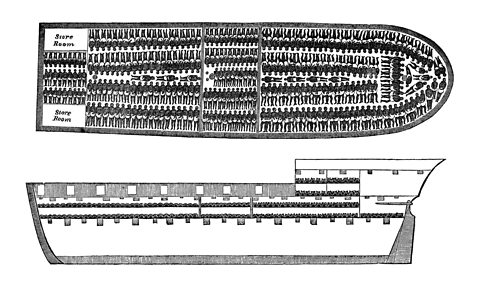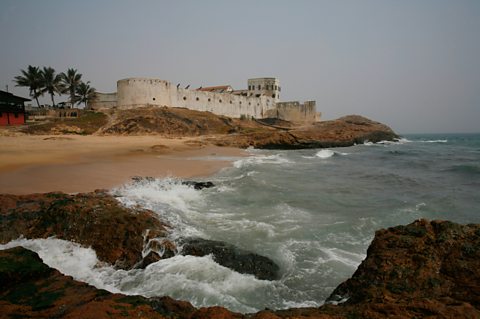What was the Transatlantic Triangular Trade?
Quick version
- The 1713 Treaty of Utrecht allows British merchants to trade enslaved Africans in Spanish South America.
- The first stage of the Triangular Trade was called the Manufactured Run and carried British-made goods to Africa to trade for captured Africans.
- The second stage of the Triangular Trade was called the Middle Passage. This stage carried enslaved Africans across the Atlantic to the Americas.
- The third stage of the Triangular Trade was called the 91»»Ī¨ Run. It brought goods created by enslaved Africans such as sugar, rum, and cotton back to British ports.
Video: The Triangular Trade
The transatlantic trade in enslaved Africans made many European traders extremely wealthy. Find out more about the trade routes in this short film.
‚ÄúOne day, when all our people were gone out to their works as usual and only I and my dear sister were left to mind the house, two men and a woman got over our walls, and in a moment seized us both, and without giving us time to cry out or make resistance they stopped our mouths and ran off with us into the nearest wood.‚ÄĚ
Between the years 1640 and 1807, British traders transported an estimated 3.1 million Africans across the Atlantic, to be forced into slavery.
For all those who were ripped away from their lives and families, it was a terrifying experience.
But for the merchant companies who ran the ships, they were just a commodity of what was to become the richest trading network the world had ever known - the ‚ÄėTriangular Trade‚Äô.
There were three stages to the Atlantic trade route… and merchants could profit from each one.
For the Outward Passage, ships were loaded with goods such as guns, gunpowder, alcohol and clothing.
These were being manufactured in the rapidly growing British cities ‚Äď such as London, Bristol, and central Scotland.
These goods weren‚Äôt usually sold for money. They were traded directly with African merchants and kingdoms ‚Äď in exchange for captured people
The price for a human life was low ‚Äď in the early 1700s, one enslaved African could be bought for just 2 muskets, or a bundle of clothing
But once shipped to the Caribbean, these people could be sold at a much higher price.
The Middle Passage crossing could last over 38 days, during which men, women and children faced disease, starvation and abuse on the overcrowded ships.
Learn in more depth
Timeline of the main events in the trade in enslaved Africans
How did the trade in enslaved Africans begin?
On 18 June 1452, Pope Nicholas V officially stated that Portugal held rights to all lands it had 'discovered' along the coast of West Africa.
The Pope authorised King Alfonso of Portugal to:
invade, search out, capture, vanquish, and subdue all Saracens and pagans whatsoever, and other enemies of Christ wheresoever placed… and reduce their persons to perpetual slavery.
This official decision to encourage a European power to enslave non-Christians was to lead to the transatlantic trade in Africans.
Spanish and Portuguese trade in enslaved Africans
The trade began with Portuguese and Spanish traders capturing African people. They transporting them to the American colonies which they had conquered in the 15th Century.
Around 350,000 Africans were taken to the Americas in this way during this period.
When did Britain begin trading in enslaved Africans?
In 1713, the Treaty of Utrecht was signed between Spain and Britain.
Spain gave British slave traders the contract, known as the Asiento, to trade 144,000 enslaved people a year to Spanish South America. After 1700, the numbers of enslaved people being transported increased greatly.
Around six million Africans were taken as enslaved people to the Americas, at least one third of them on British ships.
It has been estimated that overall, about 12 million Africans were captured to be taken to the Americas as enslaved people.
Where were enslaved Africans taken?
- over 55% of enslaved people were taken to Brazil and Spanish South America
- about 35% were taken to the West Indies
- fewer than 5% of enslaved people were sold in North America
In 1770, approximately 100,000 enslaved people were shipped from Africa to the Americas. British ships carried about 50,000 - half of these people.
In 1790, the figure for enslaved people carried to the New World was 74,000. British ships carried about 38,000 of these people, French 20,000, Portuguese 10,000, Dutch 4,000 and Danish 2,000.
British trading ships took part in the trade in enslaved people up until its eventual abolition in 1807.
What was the Triangular Trade route?
The Triangular Trade was the sailing route taken by British traders in enslaved African people. It was a journey of three stages:
- the Manufactured Run
- the Middle Passage
- the 91»»Ī¨ Run
Stage one: the Manufactured Run
British trade ships sailed to the west coast of Africa.
This stage was called the Manufactured Run, as the ships carried manufactured goods to sell and trade, including:
- cloth
- jewellery
- guns
- gunpowder
- alcohol
At first some African people were captured and enslaved directly by the British traders. However, most ships got their next cargo of enslaved people from British 'factors'.
Factors lived full-time in Africa and bought enslaved people from local African chiefs and leaders.
The chiefs would raid a rival village and sell their captured enemies into slavery. The enslaved people were marched to the coast in chained lines where they were held in prisons called 'factories'.
In 1700, an enslaved person cost about £3-worth of traded goods (cloth, guns, gunpowder and brandy).
Stage 2: the Middle Passage
Once loaded with enslaved people, the ships sailed across the Atlantic to the West Indies. This leg of the Triangular Trade was called the Middle Passage.
Conditions onboard the slaver ships were terrible
- enslaved Africans were packed into the holds of the ships. T
- there was little light or ventilation
- there were no toilet or hygiene facilities
- enslaved people were badly treated - sometimes tortured and exploited
- disease and illness led to many deaths
On arrival in the West Indies, enslaved people were sold at auction. Most went on to work as labourers on the plantations, producing crops such as sugar (and rum), coffee, cotton, and tobacco.
In 1700, the selling price of an enslaved person in the West Indies was £20. Compared to the £3 investment each enslaved person was bought for, this meant there was a good profit to be made for those willing to trade in human lives.
 Image source, ALAMY
Image source, ALAMYStage 3: the 91»»Ī¨ Run
After unloading and selling their cargo of enslaved African people n the Caribbean, trading ships would stock up on goods that would fetch a good price back in Britain and Europe.
This final stage was known as the 91»»Ī¨ Run.
Products created in the West Indies included:
- sugar
- rum
- cotton
- coffee
All of these were produced on plantations using the labour of enslaved Africans.
Successfully completing the Triangular Trade could lead to huge profits for ship owners, merchants and investors.
Test what you have learned
Quiz
Recap what you have learned
From this article you have learned that British traders became formally involved in the trade in enslaved Africans due to the Assiento ‚Äď the right to sell 144,000 Africans into slavery every year in Spanish-controlled territories in South America.
British traders employed a three-stage transatlantic journey that became known as the Triangular Trade.
- Stage One: The Manufactured Run. Trading British-made goods such as wool and guns in Africa. Traders bought enslaved Africans with the proceeds of the sales.
- Stage Two: The Middle Passage. Enslaved Africans would be transported across the Atlantic to the Americas. They would be sold at great profit to work on plantations.
- Stage Three: The 91»»Ī¨ Run. The traders bought goods produced by slave labour such as sugar, rum, cotton, and tobacco. These were sold in Europe and generated vast wealth.
More on Trade in enslaved African people
Find out more by working through a topic
- count4 of 10

- count5 of 10
